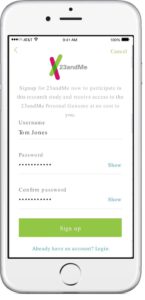23andMe announced this week that it would add access to genetic information to ResearchKit, an open source framework introduced by Apple  that allows researchers and developers to create powerful apps for medical research.
that allows researchers and developers to create powerful apps for medical research.
As an update to their existing studies, scientists at Mount Sinai and Stanford will be the first to use 23andMe’s module to incorporate genetic information from 23andMe in their research.
It is 23andMe’s first foray in what will likely be many efforts to leverage mobile technology for collecting more than just survey data as we currently do. In this case, it will be used to study asthma and heart disease.
The updated apps developed for the studies also allow 23andMe customers to easily participate after a simple informed consent process. These studies have great potential to uncover new information about asthma and heart disease. But beyond that, they also hint at the potential of integrating mobile technology into ongoing genetic research.
Scientists are already marveling at how smartphones could power this kind of research.
“Phones are always with you,” said Rob Borkowski, Ph.D., 23andMe’s Platforms Product Manager. “So unlike with a computer, you don’t have to log on and then fill in information about your activity. Your phone can record that kind of information automatically.”
A smart phone can seamlessly track activity, sleep or even the rate of your tapping, said Rob. For researchers, this kind of real-time information could help them follow the progression of an illness, and for patients a smartphone can give them a simple way of recording symptoms as they happen.

Rob Borkowski, 23andMe’s Platforms Product Manager
23andMe’s unique research platform is centered on engaging easily with customers. It offers people a simple way to participate in research if they wish, while also learning about themselves.
By leveraging online tools, 23andMe’s platform has already proven that it can accelerate the pace of research.
By integrating the smartphone into that process, it adds another layer of information for researchers to parse. It also makes it that much simpler for people to participate and that much easier for researchers to collect new kinds of data, said Gregory Frank, 23andMe’s director of business development.
Other researchers are already using smartphones to do such things as study the progression of neurodegenerative diseases by tracking changes in how patients click on their phones or gauge differences in the pace of their steps, said Gregory.
Beyond that there is the sheer number of mobile phones, even in undeveloped areas.
This opens up other avenues to find under served communities not just for researchers but for both doctors and patients interested in the delivery of mobile health care. In the short term the availability of mobile phones makes it easier to both participate in research and gather data for research.
As part of this broader effort to leverage mobile technology, 23andMe will allow researchers to broaden their efforts at recruiting not just to current 23andMe customers but enlist new participants through the ResearchKit app. (New participants get a free 23andMe kit as part of the project.) What makes this new feature attractive is that it gives scientists another tool for the sometimes difficult task of recruiting research participants.
It’s a turnkey feature for researchers, and for those who choose to participate they in turn get to contribute to research while also getting access to genetic information about themselves.



